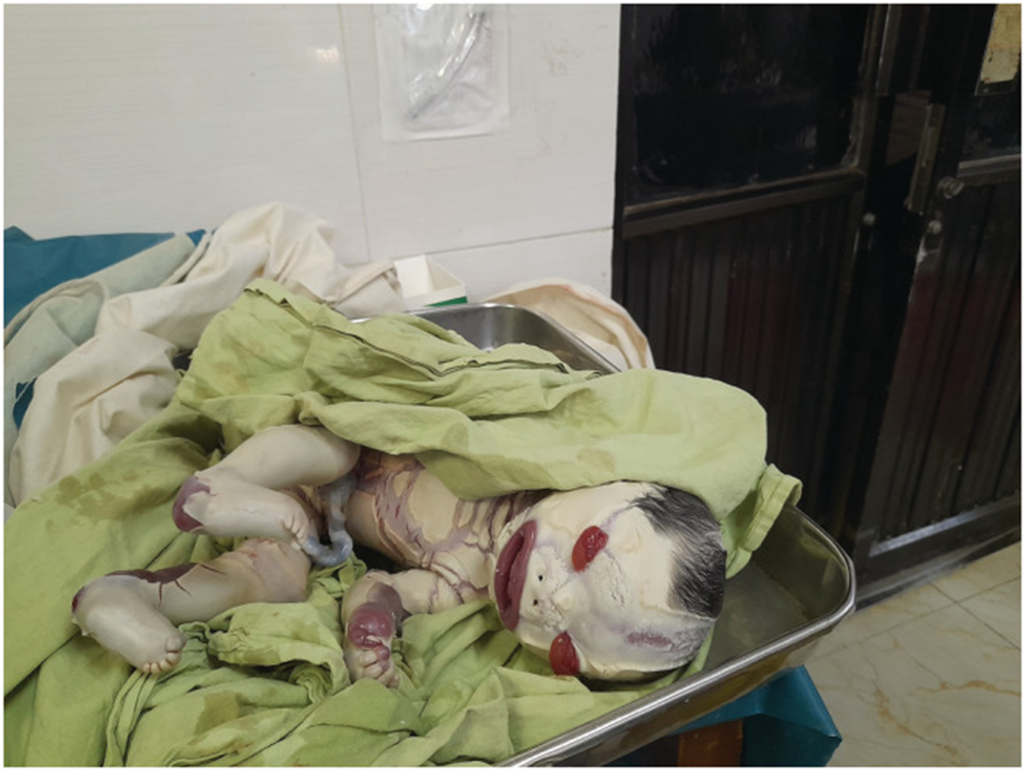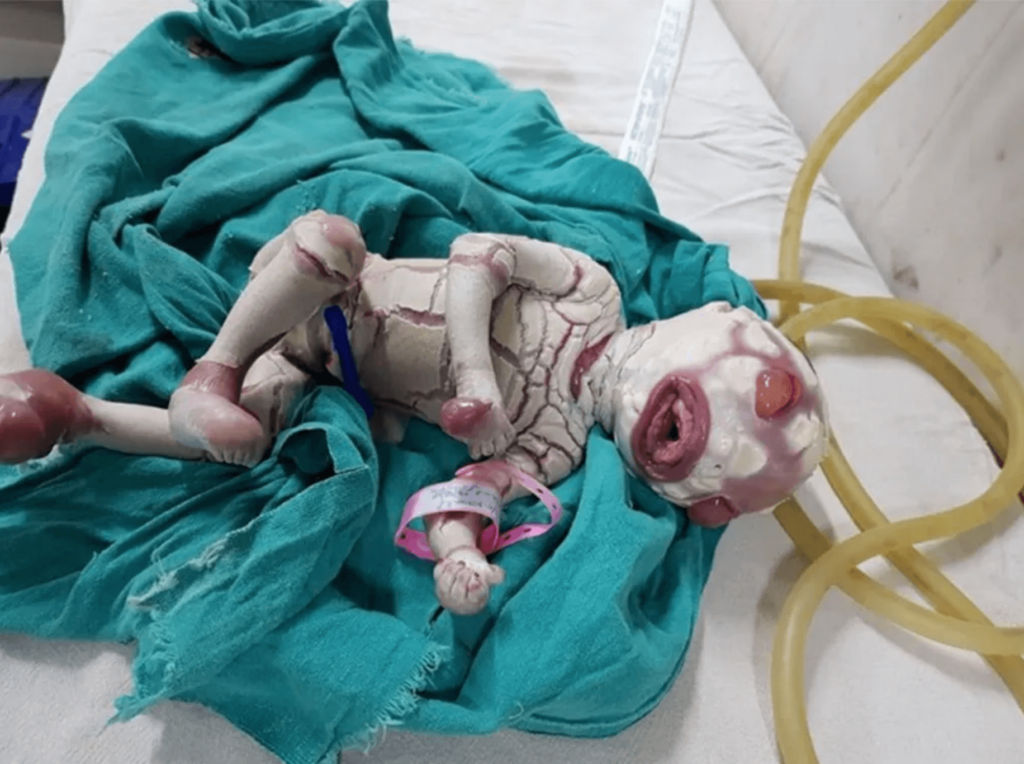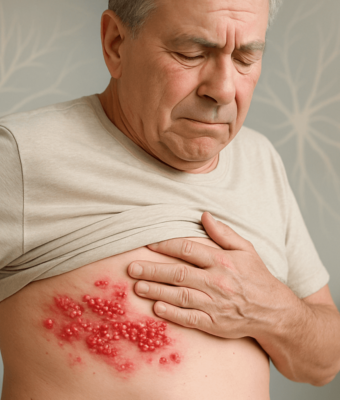Harlequin ichthyosis (HI) is the most severe form of autosomal recessive congenital ichthyosis, marked by thickened keratin and a distinctive triangular or diamond-shaped scaly skin pattern. Named for its striking facial appearance, which resembles a clown’s smile, HI features extreme ectropion and eclabium, underdeveloped ears and nose, and limited joint mobility. This compromised skin barrier leads to excessive water loss, electrolyte imbalances, temperature dysregulation, and a heightened risk of infections, making HI typically fatal despite aggressive treatment.
Harlequin Ichthyosis: Case Presentation
1. Patient Details
- A 20-year-old pregnant woman was admitted to the pediatrics department for her second pregnancy due to preterm, premature rupture of membrane and obstetric pain.
- Their gestational age was approximately 36 weeks based on the first day of her last menstrual period.
- No complications were noted in the last ultrasound examination at 28 weeks.
- Negative history of consanguineous marriage, relevant past medical history, or similar conditions in family members.
- No allergy history and immunized against Tetanus Toxoid and COVID-19.
- Her first child died from neonatal jaundice five days after birth via cesarean section a few years ago.
2. Physical Examination and Initial Treatment:
- All physical examinations were normal.
- Initial conservative treatment included Inj. Dexamethasone 5 mg, 2.5 ampoule IM stat.
- The patient was counseled for cesarean section delivery.
3. Delivery and Infant Condition:
- A female baby weighing 2.5 kg, 40 cm in height, with an occipitofrontal circumference of 35 cm, was born with Harlequin ichthyosis (Fig.1).
- Notable features included thick skin with deep fissures, general hyperkeratinization, cyanosis, flat fontanels, ectropion, immature eyes and auricles, bradycardia, bradypnea, and moaning.
- APGAR score was three at both the 1st and 5th minutes.
- The baby was immediately referred to the neonatal intensive care unit.
4. Post-Delivery Outcome:
- The father was unwilling to consent to the treatment despite several counseling attempts.
- The baby had to be discharged with a risk bond.

Figure 1: Extensive areas of diamond‐like skin and fissuring characteristic of harlequin ichthyosis.
5. Parent’s Perspective:
- The parents belonged to a lower-middle-income family with limited financial resources for treatment.
- Social stigma played a significant role in their decision not to treat the baby.
- They stated they were not informed about the condition in previous ultrasound reports and had not undergone any anomaly scan of the fetus.
- Counseling was provided about the genetic condition and the importance of caution in future pregnancies, including proper testing to detect Harlequin ichthyosis.
Discussion
Harlequin ichthyosis, known as keratosis diffuse fetal or congenital ichthyosis, is a rare genetic disorder affecting approximately 1 in 300,000 births [1]. Over 100 cases have been documented in medical literature since Oliver Hart’s first report in 1750, and this condition equally impacts both sexes [2]. It typically presents in premature babies, early pregnancies, and preterm deliveries and is often linked to consanguineous marriages [4,5].
In such cases, vaginal delivery is common, but high-risk pregnancies may necessitate a cesarean section [3]. For instance, in this case, a young mother arrived with obstetric pain and preterm premature rupture of the membrane, leading to an emergency cesarean delivery. The likelihood of recurrence in subsequent pregnancies is around 25%, making genetic counseling essential for parents to understand the risks in future conceptions [6].
Harlequin ichthyosis is unmistakably diagnosed at birth. It is characterized by large, coarse, shiny yellowish-brown hyper-keratinized plates that severely limit mobility in the arms and legs, often resulting in clenched fists and inward-curving toes. Over time, these hardened plates develop deep fissures that extend into the dermis.
Newborns with HI face numerous challenges, including growth retardation, eclabium, edema, microcephaly, and ectropion [7]. Their ear appendages and nostrils appear underdeveloped [8]. Additionally, these neonates often struggle with hypothermia, hypoglycemia, electrolyte imbalances, dehydration, infections, sepsis, poor feeding habits, renal failure, and respiratory complications due to restricted chest expansion and skeletal abnormalities. These severe complications typically lead to death within the first few days of life [9,10].
The hyperkeratotic scales typically shed for surviving patients within the first few months, leaving behind persistently red, inflamed skin. Our patient displayed all hallmark features of Harlequin ichthyosis (HI). Research has identified variations in the ABCA12 gene, which encodes a protein crucial for lipid transport in the skin, as key to the disease’s pathophysiology. Located on chromosome 2, this gene is vital in keratinocyte lipid transport across the epidermis and is essential for normal skin development and desquamation. Dysfunctional ABCA12 impairs lipid transport, leading to defective skin permeability and scale accumulation [11, 12].
Prenatal diagnosis is critical for early detection of HI. Techniques such as chorionic villous sampling, microscopic analysis of amniotic fluid cells, and advanced 3D ultrasound (particularly assessing fetal mouth shape in the early third trimester) have proven useful [13]. Akiyama et al. pioneered the first DNA-based prenatal diagnosis of HI by directly analyzing ABCA12 gene mutations in amniotic fluid cells, demonstrating the effectiveness of early genetic screening [14].
When diagnosing Harlequin ichthyosis (HI), a thorough family history, previous obstetric history, parental consanguinity, and any dermatological disorders in siblings is crucial [15]. Postnatal diagnosis often involves a skin biopsy revealing structural abnormalities in lamellar granules and epidermal keratin expression, confirmed by testing for ABCA12 gene mutations. Late phenotypic expression of HI can complicate prenatal diagnosis, as was the case with our patient, where the 28-week ultrasound showed no remarkable issues [12]. Gross fetal appearance alone is typically insufficient for diagnosis, necessitating a multi-disciplinary approach to manage complications and comorbidities.
Initial management of HI requires Neonatal Intensive Care Unit (NICU) monitoring, including supportive therapies like humidified incubators for temperature regulation and intubation for airway support. Maintaining fluids, electrolytes, and nutrition through umbilical cannulation is essential due to the difficulty of accessing peripheral veins. Limb contracture can lead to tissue necrosis and gangrene, often necessitating amputation and surgical intervention with autologous skin grafts [16]. Additional care includes physiotherapy, pain management, infection control, and regular eye care with artificial tears and ophthalmologist evaluations. Frequent ear canal debridement, mild ointments for skin softening, saline compresses for desquamation, and repeated skin cultures to detect harmful microorganisms are also recommended for comprehensive care [8].
A case series of 45 patients by Rajpot et al. highlighted that early administration of oral retinoids can facilitate the shedding of hyperkeratotic scales, leading to a survival rate exceeding 50% [17]. While systemic retinoids have shown the potential to boost survival rates, they come with risks of acute and chronic toxicity [18]. Genetic counseling and ABCA12 gene molecular investigation are crucial for future pregnancies due to the autosomal recessive nature of the disease. Additionally, exploring immunotherapy could offer new avenues for treatment.
A key aspect of managing Harlequin ichthyosis (HI) involves educating and working closely with the family, as HI often carries significant social stigma and a lack of awareness, which can further complicate care. In our case, the patient was discharged early at the father’s request due to non-compliance, underscoring the importance of family involvement and education in improving outcomes.
Conclusion
Harlequin ichthyosis is a severe, often lethal disorder that can be prevented with thorough antenatal care. Ensuring at least four routine antenatal visits is crucial in low- and middle-income countries like Bangladesh. While DNA analysis for ABCA12 mutations can diagnose the condition prenatally, it may be challenging in developing nations. An alternative approach is ultrasound during the second trimester; however, a single scan may miss the anomaly, making repeated ultrasounds highly advisable for early detection.
References
- Shrestha AB, Biswas P, Shrestha S, Riyaz R, Nawaz MH, Shrestha S, Hossainy L. Harlequin ichthyosis: A case report and literature review. Clin Case Rep. 2022 Dec 5;10(12):e6709. doi: 10.1002/ccr3.6709.
- Thomas AC, Cullup T, Norgett EE, et al. ABCA12 is the major harlequin ichthyosis gene. J Invest Dermatol. 2006;126(11):2408‐2413. doi: 10.1038/sj.jid.57004552. Ramteke S, Agrawal A, Shrivastava J. Harlequin Icthyosis: a rare disorder. Indian J Case Rep. Published Online September 27. 2016;2(3):69‐71. doi: 10.32677/IJCR. 2016.v02.i03.007
- Javed T, Afzal MF, Khan HI. Harlequin fetus: a case report. J Pak Assoc Dermatol. 2005;15(4):348‐350. Accessed September 18, 2022. http://www.jpad.com.pk/index.php/jpad/article/view/670
- Tayebi N, Yazdani K, Naghshin N. The prevalence of congenital malformations and its correlation with consanguineous marriages. Oman Med J. 2010;25(1):37‐40. doi: 10.5001/omj.2010.9
- Holden S, Ahuja S, Ogilvy‐Stuart A, Firth HV, Lees C. Prenatal diagnosis of harlequin ichthyosis presenting as distal arthrogryposis using three‐dimensional ultrasound. Prenat Diagn. 2007;27(6):566‐567. doi: 10.1002/pd.1727
- Couto PA, Pastore MC, Araújo JCN, et al. Harlequin ichthyosis: case report. J Port Soc Dermatol Venereol. 2019;77(1):55‐58. https://revista.spdv.com.pt/index.php/spdv/article/download/984/619/
- Dyer JA, Spraker M, Williams M. Care of the newborn with ichthyosis. Dermatol Ther. 2013;26(1):1‐15. doi: 10.1111/j.1529-8019.2012. 01555.x
- Salehin S, Azizimoghadam A, Abdollahimohammad A, Babaeipour‐Divshali M. Harlequin ichthyosis: case report. J Res Med Sci. 2013;18(11):1004‐1005. https://www.ncbi.nlm.nih.gov/pubmed/24520234
- Tahir A, Tariq SM, Haider SA, Hasan M. Ichthyosis congenita, harlequin type: a fatal case report. Cureus. 2018;10(10): e3524. doi: 10.7759/cureus.3524
- Kelsell DP, Norgett EE, Unsworth H, et al. Mutations in ABCA12 underlie the severe congenital skin disease harlequin ichthyosis. Am J Hum Genet. 2005;76(5):794‐803. doi: 10.1086/429844
- Fatima S, Rafiq A, Majid Z. Harlequin ichthyosis in an infant born to a father with eczema. J Trop Pediatr. 2015;61(2):143‐145. doi: 10.1093/tropej/fmu072
- Rathore S, David LS, Beck MM, Bindra MS, Arunachal G. Harlequin ichthyosis: prenatal diagnosis of a rare yet severe genetic dermatosis. J Clin Diagn Res. 2015;9(11): QD04‐QD06. doi: 10.7860/JCDR/2015/15250.6705
- Shimizu A, Akiyama M, Ishiko A, Yoshiike T, Suzumori K, Shimizu H. Prenatal exclusion of harlequin ichthyosis; potential pitfalls in the timing of the fetal skin biopsy. Br J Dermatol. 2005;153(4):811‐814. doi: 10.1111/j.1365-2133.2005. 06778.x
- Akiyama M, Titeux M, Sakai K, et al. DNA‐based prenatal diagnosis of harlequin ichthyosis and characterization of ABCA12 mutation consequences. J Invest Dermatol. 2007;127(3):568‐573. doi: 10.1038/sj.jid.5700617
- Ogbe WZ, Alarabi TGM. Harlequin ichthyosis: a case report of severe presentation in Eritrea. Clin Case Rep. 2020;8(11):2152‐2154. doi: 10.1002/ccr3.3076
- Tsivilika M, Kavvadas D, Karachrysafi S, Sioga A, Papamitsou T. Management of Harlequin Ichthyosis: a brief review of the recent literature. Children. 2022;9(6):893. doi: 10.3390/children9060893
- Rajpopat S, Moss C, Mellerio J, et al. Harlequin ichthyosis: a review of clinical and molecular findings in 45 cases. Arch Dermatol. 2011;147(6):681‐686. doi: 10.1001/archdermatol.2011.9
- Sharma A, Rozzelle A, Jahnke MN, et al. ABCA12 homozygous mutation in harlequin ichthyosis: survival without systemic retinoids. Pediatr Dermatol. 2019;36(3):339‐341. doi: 10.1111/pde.13770
About Docquity
If you need more confidence and insights to boost careers in healthcare, expanding the network to other healthcare professionals to practice peer-to-peer learning might be the answer. One way to do it is by joining a social platform for healthcare professionals, such as Docquity.
Docquity is an AI-based state-of-the-art private & secure continual learning network of verified doctors, bringing you real-time knowledge from thousands of doctors worldwide. Today, Docquity has over 400,000 doctors spread across six countries in Asia.
Meet experts and trusted peers across Asia where you can safely discuss clinical cases, get up-to-date insights from webinars and research journals, and earn CME/CPD credits through certified courses from Docquity Academy. All with the ease of a mobile app available on Android & iOS platforms!







